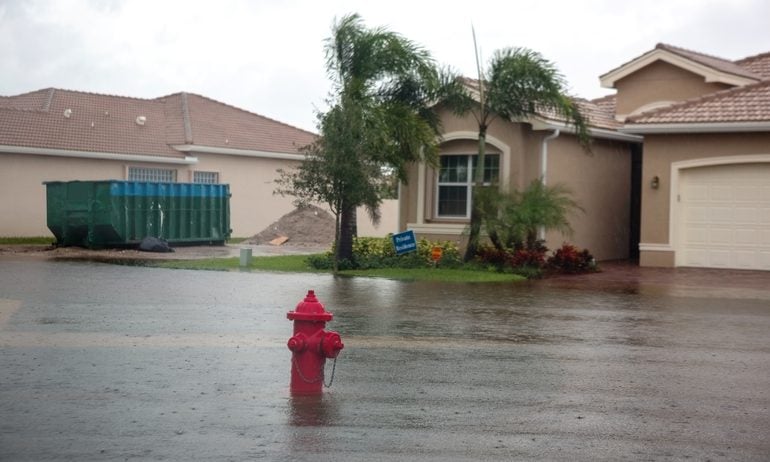How Much Does Flood Insurance Cost?
The average cost of flood insurance is about $899 per year nationwide, or $75 per month.

Many, or all, of the products featured on this page are from our advertising partners who compensate us when you take certain actions on our website or click to take an action on their website. However, this does not influence our evaluations. Our opinions are our own. Here is a list of our partners and here's how we make money.
The average cost of flood insurance from the federal government is $899 per year nationwide.
Under FEMA’s current rating system, some policyholders will find their flood insurance rates going up 18% annually for several years.
To reduce your flood insurance cost, consider raising your utilities or installing flood vents.
You’ve fallen in love with that charming little house near the river. But if you buy it, your mortgage lender will require you to get flood insurance. Will the extra expense put your dream home out of reach?
Your flood insurance cost will depend on many factors, including the size, location and elevation of your house. To get a rough idea of what you can expect to pay, check out the average costs of flood insurance below.
Get personalized quotes without the work
Let NerdWallet Insurance Experts compare quotes from popular carriers to find the right insurance coverage and rate for you. No guesswork — just expert, personalized help.
NerdWallet Insurance Experts, LLC is a wholly owned subsidiary of NerdWallet.
How much is flood insurance?
The average flood insurance cost in the U.S. is $899 a year or about $75 a month, according to NerdWallet’s analysis of 2025 National Flood Insurance Program rates. (This figure doesn't include private flood insurance policies from companies that aren't backed by the NFIP.)
Flood insurance for renters can be much cheaper if you need to cover your personal belongings only. The NFIP advertises rates as low as $100 a year for contents-only coverage.
You can get a flood insurance quote for your individual property on the NFIP’s website. But for a rough idea of how much you might pay, check out the average flood insurance rates for each state, according to NFIP data. Rates are for all NFIP policies, including commercial policies, and include the mandatory federal policy fee. Depending on where you live, your premium might be subject to discounts or other surcharges.
State | Average annual cost | Average monthly cost |
|---|---|---|
National average | $899 | $75 |
Alabama | $853 | $71 |
Alaska | $442 | $37 |
Arizona | $803 | $67 |
Arkansas | $966 | $80 |
California | $938 | $78 |
Colorado | $879 | $73 |
Connecticut | $1,404 | $117 |
Delaware | $765 | $64 |
Florida | $865 | $72 |
Georgia | $817 | $68 |
Hawaii | $755 | $63 |
Idaho | $927 | $77 |
Illinois | $1,014 | $85 |
Indiana | $962 | $80 |
Iowa | $1,245 | $104 |
Kansas | $984 | $82 |
Kentucky | $1,325 | $110 |
Louisiana | $920 | $77 |
Maine | $1,265 | $105 |
Maryland | $482 | $40 |
Massachusetts | $1,146 | $96 |
Michigan | $817 | $68 |
Minnesota | $1,045 | $87 |
Mississippi | $1,058 | $88 |
Missouri | $1,334 | $111 |
Montana | $901 | $75 |
Nebraska | $924 | $77 |
Nevada | $850 | $71 |
New Hampshire | $1,109 | $92 |
New Jersey | $1,011 | $84 |
New Mexico | $1,096 | $91 |
New York | $1,133 | $94 |
North Carolina | $833 | $69 |
North Dakota | $820 | $68 |
Ohio | $1,042 | $87 |
Oklahoma | $1,012 | $84 |
Oregon | $895 | $75 |
Pennsylvania | $1,386 | $115 |
Rhode Island | $1,046 | $87 |
South Carolina | $707 | $59 |
South Dakota | $1,128 | $94 |
Tennessee | $1,126 | $94 |
Texas | $879 | $73 |
Utah | $644 | $54 |
Vermont | $1,590 | $132 |
Virginia | $726 | $60 |
Washington | $957 | $80 |
Washington, D.C. | $440 | $37 |
West Virginia | $1,563 | $130 |
Wisconsin | $906 | $75 |
Wyoming | $942 | $78 |
If you live in an area with a higher flood risk, you’ll generally pay higher premiums. You can see your home’s risk by entering your address into the Federal Emergency Management Agency’s Flood Map Service Center. Zones that start with the letter A or V have the highest risk of flooding, while low- or moderate-risk zones start with the letters B, C or X.
Here’s how flood rates vary between higher- and lower-risk zones.
Flood zone | Average annual cost | Average monthly cost |
|---|---|---|
High risk (zones starting with A or V) | $1,031 | $86 |
Low or moderate risk (all other zones) | $691 | $58 |
Risk Rating 2.0
In October 2021, FEMA began using an approach called Risk Rating 2.0 to set flood insurance rates. FEMA now includes extra variables such as flood frequency and rebuilding cost when evaluating each home’s chance of flooding. The methodology is part of an effort to set prices that more accurately reflect each individual property's flood risk.
Flood insurance premiums dropped for about 23% of existing policyholders under the new methodology, while everyone else is paying the same or more, according to FEMA. In most cases, federal law prevents your premium from going up by more than 18% in any given year. (Exceptions include vacation homes and properties that have had multiple severe flood claims.)
Because of this cap, some existing policyholders may see their premiums rise year after year until their rate reflects what FEMA sees as the property’s true risk. The U.S. Government Accountability Office estimates that it will take until the year 2037 for 95% of NFIP policies to reach their full risk rate.
FEMA has released data showing how much the average flood insurance policy cost could go up in each state under Risk Rating 2.0. In the table below, you can see how much flood insurance policyholders were paying in each state as of August 31, 2023 (the date this information was collected). Beside that rate in the table is the amount policyholders would be paying if their rates reflected the actual flood risk of their properties as determined under Risk Rating 2.0.
Take Alabama, for example. A flood insurance policyholder there was paying an average of $825 per year in August 2023. But the true cost of flood insurance for the average property would be $1,703 per year — an increase of 106%. So an average Alabama policyholder could expect their rate to go up 18% a year for several years until they’re paying the full risk-based cost.
Note: The previous average rates below are different from the state averages in the table above because this data shows only single-family residential policies that were renewed under Risk Rating 2.0 by August 31, 2023. The table above includes all NFIP policies as of March 2025.
State | Previous average cost | Risk-based average cost | Percentage difference |
|---|---|---|---|
Alabama | $825 | $1,703 | 106% |
Alaska | $412 | $413 | 0% |
Arizona | $760 | $1,076 | 42% |
Arkansas | $781 | $1,095 | 40% |
California | $779 | $1,185 | 52% |
Colorado | $786 | $979 | 25% |
Connecticut | $1,174 | $2,514 | 114% |
Delaware | $884 | $1,265 | 43% |
Florida | $776 | $1,363 | 76% |
Georgia | $760 | $1,071 | 41% |
Hawaii | $1,023 | $3,258 | 218% |
Idaho | $825 | $1,232 | 49% |
Illinois | $873 | $1,285 | 47% |
Indiana | $800 | $994 | 24% |
Iowa | $802 | $1,216 | 52% |
Kansas | $840 | $1,146 | 36% |
Kentucky | $886 | $1,673 | 89% |
Louisiana | $786 | $1,470 | 87% |
Maine | $905 | $1,561 | 72% |
Maryland | $629 | $647 | 3% |
Massachusetts | $1,106 | $1,762 | 59% |
Michigan | $756 | $832 | 10% |
Minnesota | $858 | $1,311 | 53% |
Mississippi | $801 | $1,622 | 103% |
Missouri | $827 | $1,422 | 72% |
Montana | $836 | $1,110 | 33% |
Nebraska | $795 | $967 | 22% |
Nevada | $689 | $869 | 26% |
New Hampshire | $972 | $2,248 | 131% |
New Jersey | $953 | $1,943 | 104% |
New Mexico | $800 | $1,138 | 42% |
New York | $943 | $1,834 | 94% |
North Carolina | $780 | $1,105 | 42% |
North Dakota | $761 | $890 | 17% |
Ohio | $787 | $970 | 23% |
Oklahoma | $793 | $1,173 | 48% |
Oregon | $836 | $1,467 | 75% |
Pennsylvania | $880 | $1,623 | 84% |
Rhode Island | $986 | $1,284 | 30% |
South Carolina | $714 | $1,040 | 46% |
South Dakota | $883 | $1,317 | 49% |
Tennessee | $795 | $1,247 | 57% |
Texas | $779 | $1,188 | 53% |
Utah | $602 | $612 | 2% |
Vermont | $985 | $1,896 | 93% |
Virginia | $708 | $800 | 13% |
Washington | $795 | $1,297 | 63% |
Washington, D.C. | $395 | $397 | 0% |
West Virginia | $972 | $2,683 | 176% |
Wisconsin | $804 | $1,008 | 25% |
Wyoming | $881 | $1,138 | 29% |
What affects your flood insurance cost?
Many factors determine how much you’ll pay for flood insurance.
Your home’s location and characteristics
Under Risk Rating 2.0, FEMA looks at which flood zone your home is in and how likely your property is to flood. Your home’s flood insurance rate could vary based on answers to questions such as:
How close is the house to a river or other flood source?
How much would it cost to rebuild your home?
How high is the first floor?
How often does the surrounding area flood?
Together, these and other factors determine how likely it is that a flood could damage your home. In general, the higher the risk, the more you’ll pay for flood insurance.
Your community
If you live in a place that takes certain steps to lessen its risk of flood damage, you could be eligible for a discount on your flood insurance. These steps could include managing stormwater, maintaining levees and requiring real estate agents to disclose when a property is prone to flooding.
Your coverage and deductibles
The more coverage you need, the more your insurance will cost. So a small home that needs only $125,000 of building coverage will generally have a lower flood insurance rate than a larger one that needs the NFIP’s maximum of $250,000 in building coverage (all other factors being equal).
Choosing a higher deductible — the amount of a claim you pay yourself — will generally lower your premium.
How to save on flood insurance
You may be able to shave a bit off your premium by taking the following steps.
Reduce your flood risk
If you take steps to reduce your home’s chance of flood damage, you could see a discount on your insurance. The NFIP recommends:
Installing flood vents on exterior walls. These openings allow water to flow between the outside and inside of your foundation, equalizing pressure and preventing collapse.
Filling in your basement or crawl space. In some high-risk areas, you may pay 15% to 20% more for flood insurance if you have a basement.
Raising utilities. Moving your heating, ventilating and air conditioning systems, water heaters and other utilities to an attic or elevated platform can help protect them from flood damage.
Elevating your house or moving it to a new location. These options are pricey enough that they’re probably not worth doing just to get a discount on your flood insurance. However, if your home is in a high-risk location or has flooded before, taking these steps may spare you the stress and hassle of dealing with flood damage in the future.
Submit an elevation certificate
An elevation certificate shows the elevation of your home’s lowest floor, plus the building’s location and features. The NFIP doesn’t require you to have an elevation certificate to get a policy. But sometimes providing your insurance agent with a certificate could help you qualify for a lower rate.
To get an elevation certificate, ask your local flood plain manager if there’s one on file for your home. You can also check whether your property deed includes an elevation certificate.
If your home doesn’t have an elevation certificate, you can hire a land surveyor, engineer or architect to create one.
Shop around
There may be private insurance companies in your area that will cover your property at a lower rate than the NFIP. You can find them by contacting a local insurance agent. Learn more about private flood insurance.
Adjust your deductible or coverage limits
As noted above, choosing a higher deductible or buying less coverage can help you lower your annual flood insurance cost. But either option will leave you responsible for paying more in the event of a claim. Be sure you'll have enough cash on hand if needed.
NerdWallet used the National Flood Insurance Program’s most recent “Policy Information by State” report to calculate the average cost of flood insurance in each state and across the country for all policyholders. To determine the national average, we divided the total written premium for all communities across the U.S. by the total number of policies in force. To determine the average for each state, we divided the total written premium for all communities within that state by the state’s total number of policies in force. Rates are based on residential and nonresidential policies. Total written premiums include the mandatory federal policy fee.
We used the National Flood Insurance Program’s most recent “Policies in Force by Occupancy Type/Zone” report to calculate the average cost of flood insurance by zone. The Federal Emergency Management Agency defines higher-risk zones as those starting with the letter A or V. All other zones are considered lower-risk zones. To find the averages, we divided the total written premium for each zone grouping by the number of policies in force. Rates are based on residential and nonresidential policies. Total written premiums include the mandatory federal policy fee.
To show the difference between current rates and risk-based rates under Risk Rating 2.0, we used the National Flood Insurance Program’s “Cost of Flood Insurance for Single-Family Homes under Risk Rating 2.0” data, showing policies that were in force as of August 31, 2023, and rated under Risk Rating 2.0. We calculated the percentage difference between the average rates that flood insurance policyholders are currently paying in each state and the rates that reflect their properties’ true flood risk under Risk Rating 2.0. Rates are for single-family residential policies.
ON THIS PAGE
ON THIS PAGE





